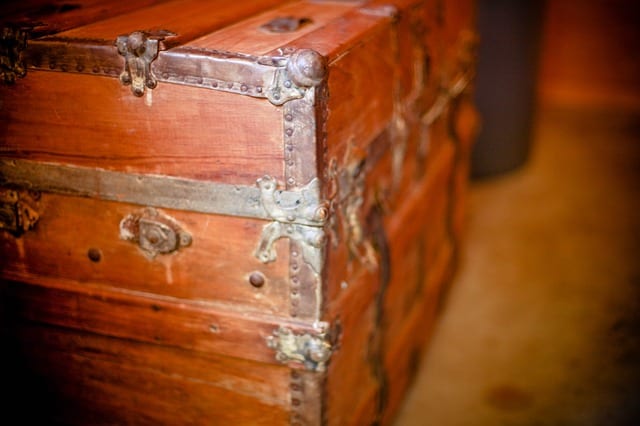It was strategically positioned in the eaves of the attic, wedged between the rafters, yet easily accessible to the adjoining rooms of the center hall Cape Cod, my beloved childhood home, built by my father in 1953.
Indeed, it was far more than a mere storage box for blankets, sweaters and rarely used tablecloths. It was majestic in size, handcrafted from oak, donned in a lacquer finish with a heavy hinged lid…the old cedar chest. Embellished with an antique keyhole, lined in a dark navy-blue fabric, with its accordion shelves and zippered compartments, the cedar chest served for well over half a century as an archival of precious moments lived.
Within its wooden confines, an accumulation of what appeared to be random items, but upon closer observation, these items shared a commonality, each was tethered to a milestone, or a celebration, or sadly the loss of a loved one. Collectively these items wove a tapestry of memories, a threaded recollection of days gone by. As a child, when delegated the task of placing an item in the cedar chest, I was honored and took to my chore very seriously, for even I knew at a very early age that the mere act of placing an item in the cedar chest indicated it had earned a distinction. It bore significance worthy of preservation. With all my strength, I would open the cedar chest lid and just as the sweet smell of cedar wafted through the attic, I would gingerly place the designated item in the chest.
Upon the sale of my childhood home, the cedar chest, intact with all its belongings, was relocated to my home, thus becoming a permanent fixture. With rapid succession, the months have tumbled into decades, the pendulum of time has swayed and clanged, rhythmically moving forward, and so too has my need to now downsize. Hence the recurring conundrum, what to do with the cedar chest and its enormous consumption of space?
For certain, the items within it are tangible, their noteworthiness indelibly etched in the cobweb-ridden corners of my mind. After much deliberation, I reach an internal compromise, doused in a philanthropic gesture. I will retain the myriad of articles within the chest and donate the chest to a worthy not for profit organization seeking furniture.
My search begins. As I reach out to not for profits, I envision a young family utilizing the massive chest in the same manner as my family, filling its vastness over the course of a lifetime with meaningful articles. For a brief moment, I conjure the image and likeness of myself from decades ago, a dark-haired petite pony tailed girl climbing into an attic with treasured objects in hand, placing them ever so carefully into the cedar chest with the same excitement and privilege I once wore.
My inquiry ends. I find a gracious not for profit delighted to take the cedar chest. I finalize arrangements for pick-up and begin the daunting task of combing through the chest’s colossal collection. I experience a disparate awakening. Certain items barely jar the memory, while others stir the soul creating a resurrection of particular events, detailed conversations from years ago.
Within the chest, a christening gown, pressed flowers, baby shoes, vintage birthday cards, letters, postcards, a wedding dress, rosary beads, a crucifix, vintage sewing patterns, an unfinished embroidered doily, black and white photos in scalloped frames. Each cherished item has marked the passage of time in its own unique way. Collectively the retained articles create an emotionally wrought canvas painted with brushstrokes of happiness, sadness and some regret.
Suddenly I am ridden with guilt as a thought occurs to me. It weighs heavy on the heart and casts a dark shadow upon my initially perceived benevolent quest to donate the old cedar chest. I begin to contemplate, have I made the right choice? Have I haphazardly discarded a family heirloom? As I grapple with the thought that my initial decision to donate the cedar chest may have been rash, fueled by my own selfishness, my mind wanders to the detailed rendered sketch of the little girl placing keepsakes in the cedar chest.
With some hesitation, I ultimately decide to donate the chest. The scheduled pick-up day arrives. I wait in the driveway, admittedly still vacillating with my final decision. I open the hinged lid one last time; my fingers caress the soft cedar lining and stumble across a bulge beneath the zippered compartment. I pull back the zipper and it reveals additional storage space. Deep within this hidden pocket, I discover my Father’s World War II Naval uniform.
Throughout the years, I had seen a plethora of pictures and heard detailed accounts about my Father’s time served in the Navy during wartime. I tightly clutch the uniform with its dangling brass buttons and its medals of honor still neatly pinned on its rolled sleeves. Just then, the pick-up truck arrives, the huge white lettering on its side reads, “We Help Veterans.” Rather suddenly my ultimate decision to donate is completely validated by a strong belief that this final sequence of events was not merely coincidental. For sure, the cedar chest is where it belongs, so too is my Father’s Naval uniform, in my arms as a remembrance of his days bravely defending America.






















